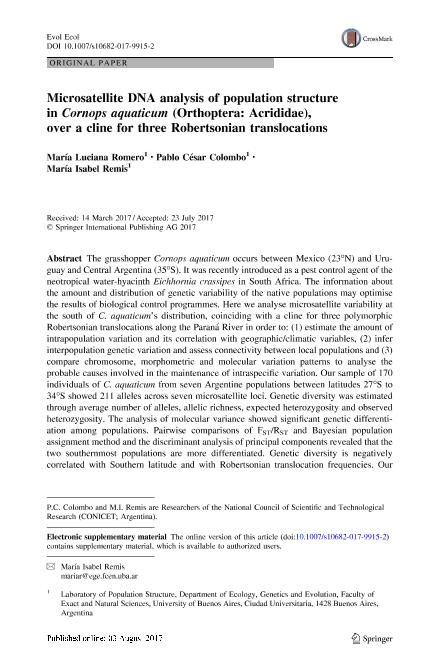Mostrar el registro sencillo del ítem
dc.contributor.author
Romero, Maria Luciana

dc.contributor.author
Colombo, Pablo Cesar

dc.contributor.author
Remis, Maria Isabel

dc.date.available
2018-11-26T14:38:48Z
dc.date.issued
2017-12
dc.identifier.citation
Romero, Maria Luciana; Colombo, Pablo Cesar; Remis, Maria Isabel; Microsatellite DNA analysis of population structure in Cornops aquaticum (Orthoptera: Acrididae), over a cline for three Robertsonian translocations; Springer; Evolutionary Ecology; 31; 6; 12-2017; 937-953
dc.identifier.issn
0269-7653
dc.identifier.uri
http://hdl.handle.net/11336/65125
dc.description.abstract
The grasshopper Cornops aquaticum occurs between Mexico (23°N) and Uruguay and Central Argentina (35°S). It was recently introduced as a pest control agent of the neotropical water-hyacinth Eichhornia crassipes in South Africa. The information about the amount and distribution of genetic variability of the native populations may optimise the results of biological control programmes. Here we analyse microsatellite variability at the south of C. aquaticum’s distribution, coinciding with a cline for three polymorphic Robertsonian translocations along the Paraná River in order to: (1) estimate the amount of intrapopulation variation and its correlation with geographic/climatic variables, (2) infer interpopulation genetic variation and assess connectivity between local populations and (3) compare chromosome, morphometric and molecular variation patterns to analyse the probable causes involved in the maintenance of intraspecific variation. Our sample of 170 individuals of C. aquaticum from seven Argentine populations between latitudes 27°S to 34°S showed 211 alleles across seven microsatellite loci. Genetic diversity was estimated through average number of alleles, allelic richness, expected heterozygosity and observed heterozygosity. The analysis of molecular variance showed significant genetic differentiation among populations. Pairwise comparisons of FST/RST and Bayesian population assignment method and the discriminant analysis of principal components revealed that the two southernmost populations are more differentiated. Genetic diversity is negatively correlated with Southern latitude and with Robertsonian translocation frequencies. Our results showed that the Paraná River’s middle course populations are genetically undifferentiated and more genetically diverse than the highly chromosomally polymorphic downstream ones. The chromosomal polymorphisms are associated with increased body size in the direction in which larger size is adaptive. This may be relevant for C. aquaticum’s role as a pest control agent, since chromosome variability would enhance the ability of the species for a successful settlement in its new habitats, especially in temperate regions of the world.
dc.format
application/pdf
dc.language.iso
eng
dc.publisher
Springer

dc.rights
info:eu-repo/semantics/openAccess
dc.rights.uri
https://creativecommons.org/licenses/by-nc-sa/2.5/ar/
dc.subject
Chromosome Polymorphism
dc.subject
Host Specific Herbivores
dc.subject
Microsatellite Diversity
dc.subject
Population Genetics
dc.subject.classification
Otras Ciencias Biológicas

dc.subject.classification
Ciencias Biológicas

dc.subject.classification
CIENCIAS NATURALES Y EXACTAS

dc.title
Microsatellite DNA analysis of population structure in Cornops aquaticum (Orthoptera: Acrididae), over a cline for three Robertsonian translocations
dc.type
info:eu-repo/semantics/article
dc.type
info:ar-repo/semantics/artículo
dc.type
info:eu-repo/semantics/publishedVersion
dc.date.updated
2018-10-23T18:35:51Z
dc.journal.volume
31
dc.journal.number
6
dc.journal.pagination
937-953
dc.journal.pais
Alemania

dc.journal.ciudad
Berlin
dc.description.fil
Fil: Romero, Maria Luciana. Consejo Nacional de Investigaciones Científicas y Técnicas. Oficina de Coordinación Administrativa Ciudad Universitaria. Instituto de Ecología, Genética y Evolución de Buenos Aires. Universidad de Buenos Aires. Facultad de Ciencias Exactas y Naturales. Instituto de Ecología, Genética y Evolución de Buenos Aires; Argentina
dc.description.fil
Fil: Colombo, Pablo Cesar. Consejo Nacional de Investigaciones Científicas y Técnicas. Oficina de Coordinación Administrativa Ciudad Universitaria. Instituto de Ecología, Genética y Evolución de Buenos Aires. Universidad de Buenos Aires. Facultad de Ciencias Exactas y Naturales. Instituto de Ecología, Genética y Evolución de Buenos Aires; Argentina
dc.description.fil
Fil: Remis, Maria Isabel. Consejo Nacional de Investigaciones Científicas y Técnicas. Oficina de Coordinación Administrativa Ciudad Universitaria. Instituto de Ecología, Genética y Evolución de Buenos Aires. Universidad de Buenos Aires. Facultad de Ciencias Exactas y Naturales. Instituto de Ecología, Genética y Evolución de Buenos Aires; Argentina
dc.journal.title
Evolutionary Ecology

dc.relation.alternativeid
info:eu-repo/semantics/altIdentifier/url/http://link.springer.com/10.1007/s10682-017-9915-2
dc.relation.alternativeid
info:eu-repo/semantics/altIdentifier/doi/https://dx.doi.org/10.1007/s10682-017-9915-2
Archivos asociados
